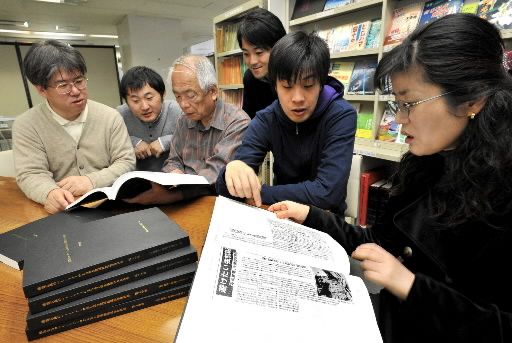"Light and shadows" of Hiroshima’s reconstruction seen in compilation of 1,418 articles
Mar. 31, 2010
by Masami Nishimoto, Senior Staff Writer
The Hiroshima Association of Korean Society Studies has finished "A Compilation of Newspaper Articles: Eviction and Other Issues Involving the Minority in Postwar Hiroshima." It reviews the "light and shadows" of the days Hiroshima sought to rise from the devastation of the atomic bombing. Focusing on the lives endured by the so-called "Zainichi" (Korean residents in Japan) and A-bomb survivors, 1,418 articles found in the Chugoku Shimbun from 1945 to 1978 have been included in the compiled work. The effort also evokes challenges inherent in urban development that remain applicable to today.
Lee Dong-Suk, 49, head of the association and an associate professor at the Graduate School of Integrated Arts and Sciences, Hiroshima University, along with postgraduates from Hiroshima Municipal University, Osaka Municipal University, former high school teachers and others, has pursued this project over the last three years, assisted by a grant for scientific research.
The selected articles are categorized into 12 areas including: designing reconstruction projects and lobbying the central government; activities initiated by the mayor of Hiroshima and others three months after the bombing; the construction of public housing, parks, and streets that began soon after the Hiroshima Peace Memorial City Construction Law was proclaimed in 1949; the relocation order and expropriation of properties along the rivers which had been left behind amid the high economic growth; and the reconstruction of the Motomachi area up to 1978 when Hiroshima prefecture and city completed this effort. Along with the collection of articles is a table of contents, headlines, and groupings by area.
Takuya Motooka, 30, a member of the group who is also engaged in research on the reconstruction efforts that took place after the Great Hanshin Earthquake of 1995, noted that "Hiroshima's reconstruction project is unprecedented in scale, process, and the number of reports in the press. It was also an experience that can be utilized in similar efforts in the future to protect residents' rights." Kweon Hyon Gi, 27, whose grandfather was forced to leave his Motomachi house, commented that "I was able to take a close look at an aspect of history that even my compatriots have spoken little about."
Lee Dong-Suk is from South Korea and he plans to have the work placed in Hiroshima University's Central Library and Hiroshima Prefectural Library, hoping it will inspire people to reflect on today's social divide by learning about the course the A-bombed city took in the post-war period and those who were forced into disadvantage in the process of its reconstruction.
(Originally published on March 23, 2010)
The Hiroshima Association of Korean Society Studies has finished "A Compilation of Newspaper Articles: Eviction and Other Issues Involving the Minority in Postwar Hiroshima." It reviews the "light and shadows" of the days Hiroshima sought to rise from the devastation of the atomic bombing. Focusing on the lives endured by the so-called "Zainichi" (Korean residents in Japan) and A-bomb survivors, 1,418 articles found in the Chugoku Shimbun from 1945 to 1978 have been included in the compiled work. The effort also evokes challenges inherent in urban development that remain applicable to today.
Lee Dong-Suk, 49, head of the association and an associate professor at the Graduate School of Integrated Arts and Sciences, Hiroshima University, along with postgraduates from Hiroshima Municipal University, Osaka Municipal University, former high school teachers and others, has pursued this project over the last three years, assisted by a grant for scientific research.
The selected articles are categorized into 12 areas including: designing reconstruction projects and lobbying the central government; activities initiated by the mayor of Hiroshima and others three months after the bombing; the construction of public housing, parks, and streets that began soon after the Hiroshima Peace Memorial City Construction Law was proclaimed in 1949; the relocation order and expropriation of properties along the rivers which had been left behind amid the high economic growth; and the reconstruction of the Motomachi area up to 1978 when Hiroshima prefecture and city completed this effort. Along with the collection of articles is a table of contents, headlines, and groupings by area.
Takuya Motooka, 30, a member of the group who is also engaged in research on the reconstruction efforts that took place after the Great Hanshin Earthquake of 1995, noted that "Hiroshima's reconstruction project is unprecedented in scale, process, and the number of reports in the press. It was also an experience that can be utilized in similar efforts in the future to protect residents' rights." Kweon Hyon Gi, 27, whose grandfather was forced to leave his Motomachi house, commented that "I was able to take a close look at an aspect of history that even my compatriots have spoken little about."
Lee Dong-Suk is from South Korea and he plans to have the work placed in Hiroshima University's Central Library and Hiroshima Prefectural Library, hoping it will inspire people to reflect on today's social divide by learning about the course the A-bombed city took in the post-war period and those who were forced into disadvantage in the process of its reconstruction.
(Originally published on March 23, 2010)








